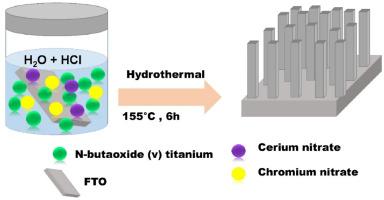Creating an intermediate energy band to boost the photoelectrochemical efficiency of TiO2 for solar-driven hydrogen production
IF 6.3
2区 材料科学
Q2 ENERGY & FUELS
引用次数: 0
Abstract
The utilization of photoelectrochemical processes for hydrogen generation from water and solar energy offers a promising avenue to replace non-renewable energy sources. Nevertheless, achieving high-performance photoanode electrodes poses a significant challenge. In this study, we present the synthesis cerium and chromium-doped TiO2 (CeCrTiO2) is produced through a simple, scalable, and cost-effective hydrothermal method on a fluorine-doped tin oxide (FTO) substrate. the introduction of Ce and Cr impurities is highlighted for its role in creating an impurity band within CeCrTiO2. This impurity band is instrumental in enhancing the separation and movement of electrons and holes, contributing to the improved performance of CeCrTiO2 as a photoanode in photoelectrochemical applications. Hence, the photocurrent density value of CeCrTiO2 is 4.5 times higher than that of bare TiO2. This suggests that CeCrTiO2 exhibits improved efficiency in generating a photocurrent when exposed to light, indicating enhanced photoelectrochemical performance. The amount of hydrogen produced by CeCrTiO2 is noted to be 4.88 times greater than that of bare TiO2. This highlights the material's effectiveness in harnessing solar energy to drive the water-splitting reaction, leading to a higher yield of hydrogen gas. The synthesis of CeCrTiO2 through a hydrothermal method results in a photoanode with significantly enhanced performance, positioning it as a promising candidate for advancing photoelectrochemical processes aimed at replacing non-renewable energy sources.

创建中间能带,提高二氧化钛的光电化学效率,促进太阳能制氢
利用光电化学过程从水和太阳能中制氢,为替代不可再生能源提供了一条前景广阔的途径。然而,实现高性能光阳极电极是一项重大挑战。在本研究中,我们介绍了在掺氟氧化锡(FTO)基底上通过简单、可扩展且经济有效的水热法合成掺铈和铬的二氧化钛(CeCrTiO2)的过程。该杂质带有助于加强电子和空穴的分离和移动,从而提高 CeCrTiO2 作为光阳极在光电化学应用中的性能。因此,CeCrTiO2 的光电流密度值是裸 TiO2 的 4.5 倍。这表明 CeCrTiO2 在光照下产生光电流的效率有所提高,从而增强了光电化学性能。CeCrTiO2 产生的氢气量是裸 TiO2 的 4.88 倍。这凸显了该材料在利用太阳能驱动分水反应方面的有效性,从而提高了氢气产量。通过水热法合成 CeCrTiO2 可得到性能显著增强的光阳极,使其成为推动旨在替代不可再生能源的光电化学过程的理想候选材料。
本文章由计算机程序翻译,如有差异,请以英文原文为准。
求助全文
约1分钟内获得全文
求助全文
来源期刊

Solar Energy Materials and Solar Cells
工程技术-材料科学:综合
CiteScore
12.60
自引率
11.60%
发文量
513
审稿时长
47 days
期刊介绍:
Solar Energy Materials & Solar Cells is intended as a vehicle for the dissemination of research results on materials science and technology related to photovoltaic, photothermal and photoelectrochemical solar energy conversion. Materials science is taken in the broadest possible sense and encompasses physics, chemistry, optics, materials fabrication and analysis for all types of materials.
 求助内容:
求助内容: 应助结果提醒方式:
应助结果提醒方式:


